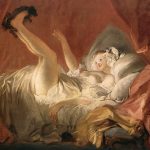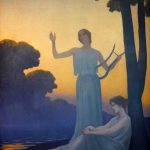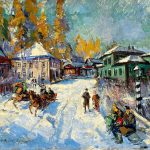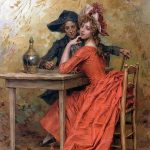Jean-Antoine Watteau, born on October 10, 1684, in Valenciennes, France, emerged as one of the most influential painters of the early 18th century. His life, though brief, left an indelible mark on the art world, particularly through his contributions to the Rococo movement. Watteau’s mastery in portraying the subtleties of human emotion, coupled with his innovative approach to composition and subject matter, positioned him as a pivotal figure in the evolution of French art during the transition from the Baroque to the Rococo era.
Coming from a modest background, Watteau demonstrated an early affinity for art. He apprenticed with local painters in Valenciennes, honing his skills in the techniques of oil painting and drawing. His talent soon caught the attention of the local artistic community, leading to his relocation to Paris around 1702 in pursuit of greater opportunities for artistic growth.
Paris, with its vibrant artistic milieu, provided Watteau with exposure to various styles and influences. Initially struggling to establish himself, he found solace in the circle of the theatrical and artistic community, which played a pivotal role in shaping his artistic vision. Watteau’s fascination with the theater and the world of commedia dell’arte performers would later permeate his paintings, imbuing them with a sense of theatricality and emotional depth.
Watteau’s breakthrough came with his submission to the Royal Academy’s prestigious painting competition, the Prix de Rome, in 1709. His entry, “The Departure from Cythera,” marked a departure from traditional themes and showcased his innovative approach to composition and narrative. The painting, characterized by its delicate color palette and fluid brushwork, garnered attention for its poetic portrayal of a mythological subject.
Despite not winning the Prix de Rome, Watteau’s reputation continued to grow, attracting the patronage of influential figures. His unique style, often described as fête galante, introduced a new genre characterized by scenes of elegant figures engaged in leisurely activities within lush, pastoral settings. This departure from the grand historical and mythological themes of the Baroque era marked the beginning of the Rococo movement.
Watteau’s artistry flourished during a period of profound cultural shifts in France. The aftermath of the War of Spanish Succession brought about a desire for a more lighthearted and refined aesthetic, aligning perfectly with the themes present in Watteau’s work. His paintings, such as “Pilgrimage to Cythera” and “The Embarkation for Cythera,” exemplify the Rococo spirit, capturing the essence of love, romance, and the transient nature of pleasure.
The artist’s health, however, was fragile, and he battled chronic illness throughout his life. Despite his physical challenges, Watteau’s creative output remained prolific. His innovative use of color, atmospheric effects, and the portrayal of fleeting moments distinguished him as a trailblazer in the evolving landscape of French art.
Watteau’s engagement with the Parisian art scene extended beyond his canvases. He became a central figure in the artistic salons, contributing to the intellectual and creative discussions of the time. His friendships with fellow artists, such as Nicolas Lancret and François Boucher, underscored the collaborative and supportive nature of the Rococo community.
Tragically, Watteau’s life was cut short at the age of 37 when he succumbed to tuberculosis on July 18, 1721. His untimely death left a void in the art world, but his legacy endured through the impact of his revolutionary contributions. Watteau’s influence extended to later generations of artists, including Jean-Honoré Fragonard and François Boucher, who carried forward the Rococo legacy.
The significance of Watteau’s work transcends mere aesthetic appeal. His emphasis on capturing the fleeting beauty of life, the exploration of emotions, and the celebration of the everyday paved the way for the cultural shift towards a more refined and nuanced artistic expression. The fête galante genre, with its elegance and charm, became a defining feature of the Rococo movement, challenging the prevailing norms and setting the stage for the artistic developments of the 18th century.
In the centuries following his death, Watteau’s paintings continued to captivate audiences and art connoisseurs. His influence reached beyond the borders of France, impacting the trajectory of European art. The delicate poignancy of his scenes, the mastery of his brush, and the introspective quality of his work solidified Watteau’s status as a luminary in the annals of art history, leaving an enduring legacy that transcends the confines of his brief existence.






